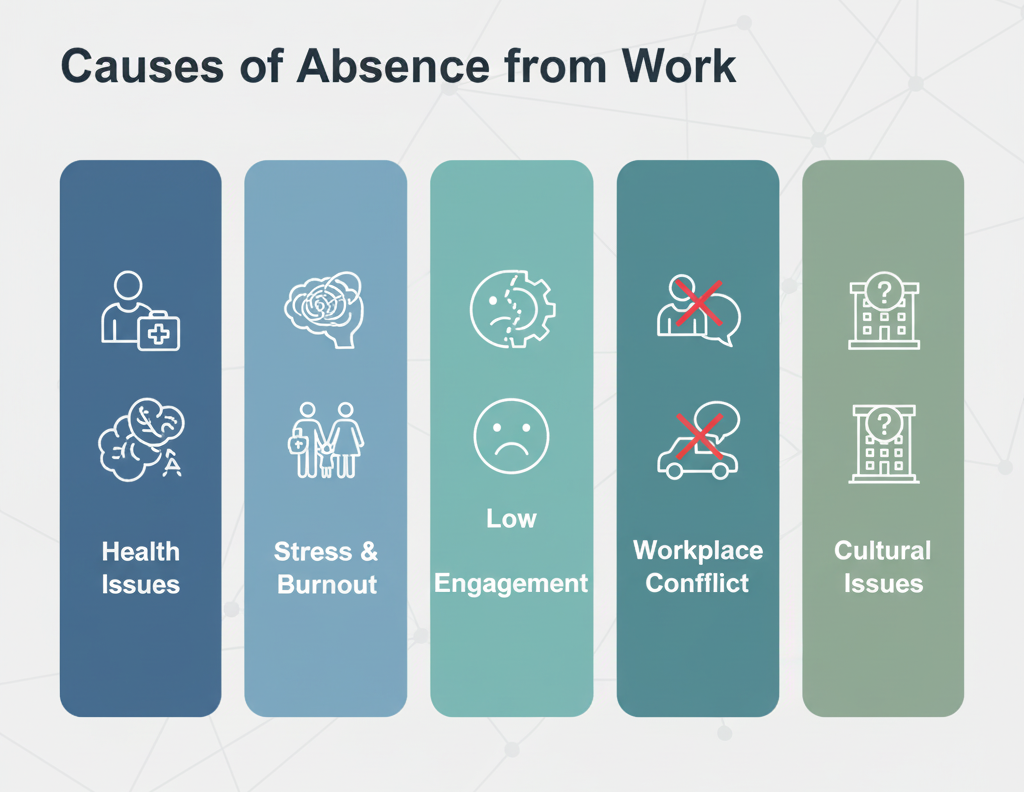Picture this: You walk into an office on Monday morning, and half the desks are empty. Some employees have called in sick, others have simply not shown up, and productivity for the day is already falling behind. This is not an isolated problem. It is a recurring issue known as absenteeism, and it impacts organizations of all sizes.
So, what is absenteeism?
At its simplest, absenteeism is when employees frequently miss work without valid reasons. While planned absences like vacations or medical leave are normal and expected, chronic or unexplained absences disrupt workflow, lower morale, and create financial strain on businesses.
Absenteeism has become a pressing concern today. With hybrid work, rising mental health challenges, and employee burnout at record highs, organizations are struggling to balance flexibility with accountability. The costs are staggering. Studies have found that absenteeism costs businesses billions in lost productivity worldwide each year. According to SHRM, unplanned absences reduce productivity by up to 36% because other employees are forced to cover additional work.
For employees, absenteeism can also mean stress, stalled career growth, or damaged workplace relationships. That is why understanding the definition of absenteeism, its causes, and how to manage it effectively is critical for organizations that want to maintain healthy and motivated teams.
This article will explore the meaning of absenteeism, its different types, the causes of absence from work, its impact on both organizations and employees, and the most effective strategies to reduce it.

What Does Absenteeism Mean?
Absenteeism refers to the habitual or repeated absence of an employee from work without valid reasons. In simple words, it is the practice of missing work frequently beyond what is considered normal or acceptable.
To better understand absenteeism, it helps to distinguish between planned and unplanned absences. Planned absences include approved vacation time, maternity leave, or medical leave. These are scheduled and accounted for in advance. Unplanned absences, on the other hand, are unscheduled and often happen without notice, creating disruption for managers and teams.
In the workplace context, the term employee absenteeism is often used. This focuses specifically on recurring work absences that go beyond legitimate leave. It differs from occasional sick days, which are unavoidable. Chronic absenteeism indicates a pattern of absence that signals deeper issues, such as disengagement, health problems, or poor management practices.
Absenteeism is also different from presenteeism. Presenteeism occurs when employees physically show up at work but are not productive due to illness, stress, or disengagement. While absenteeism is about not being present at all, presenteeism means being present without contributing effectively. Both create challenges for organizations.
Understanding absenteeism’s meaning helps organizations recognize that not all absences are equal. Some are unavoidable and legitimate, while others point to systemic problems within the workplace. By clearly defining absenteeism, organizations can design policies that address it fairly without penalizing necessary time off.
Types of Absenteeism
Absenteeism takes many forms. Breaking it down into categories makes it easier for managers to identify patterns and respond appropriately. Here are the main types of absenteeism.
Authorized vs. Unauthorized Absenteeism
Authorized absenteeism includes approved leaves, such as vacations, personal days, or medical leave. Unauthorized absenteeism happens when employees miss work without prior approval or explanation. The latter often signals disengagement or personal struggles.
Short-Term vs. Long-Term Absenteeism
Short-term absenteeism usually involves one or two days away from work, often due to sudden illness. Long-term absenteeism refers to extended absences, such as recovery from surgery or long-term caregiving duties. Both require different management approaches.
Chronic Absenteeism
This occurs when an employee consistently misses work over time. Chronic absenteeism is particularly disruptive and is often linked to deeper issues such as workplace dissatisfaction, mental health struggles, or personal challenges.
Voluntary vs. Involuntary Absenteeism
Voluntary absenteeism is when employees choose to stay away from work despite being able to attend. Involuntary absenteeism is beyond the employee’s control, such as accidents, health issues, or family emergencies.
By understanding these categories, organizations can differentiate between valid and problematic absences. Recognizing the type of absenteeism also helps HR teams apply fair policies and offer support where it is needed most.
Causes of Absence from Work
Absenteeism rarely happens without reason. Understanding the causes of absence from work allows leaders to address root problems rather than just symptoms.
Health Issues and Chronic Conditions
Illnesses, injuries, and chronic health conditions are some of the most common causes of absenteeism. Employees with ongoing medical issues may require extended or repeated time off.
Stress, Burnout, and Mental Health
Stress and burnout have become leading causes of absenteeism in the workplace. Employees under constant pressure may experience exhaustion or mental health issues that make it difficult to attend work consistently.
Family or Caregiving Responsibilities
Employees often need time off to care for children, elderly parents, or sick family members. These responsibilities can result in recurring absences, especially when flexible policies are lacking.
Lack of Engagement or Job Dissatisfaction
Disengaged employees are more likely to be absent. If employees feel undervalued, unchallenged, or unsupported, absenteeism can become a form of silent protest.
Workplace Conflicts or Poor Management
Toxic environments or strained relationships with managers often drive absenteeism. When employees do not feel respected or supported, they may choose to avoid work.
Transportation and Commute Challenges
Long commutes, unreliable transport, or distance can discourage regular attendance. Remote or hybrid options often reduce this issue.
Cultural or Organizational Issues
Rigid attendance policies, lack of flexibility, or poor communication can worsen absenteeism. An unsupportive workplace culture often drives higher absence rates.
Studies from ScienceDirect show that stress, burnout, and disengagement are increasing drivers of absenteeism globally, highlighting the need for proactive solutions.

Impact of Absenteeism on Organizations
Absenteeism does not just affect individual employees. It has far-reaching consequences for the entire organization. Even a few recurring absences can disrupt teamwork, reduce productivity, and create hidden costs that build up over time.
Productivity Loss and Missed Deadlines
When employees are absent, projects get delayed, deadlines slip, and tasks may not be completed as planned. This disrupts workflow and forces managers to redistribute responsibilities, often leading to inefficiencies.
Increased Burden on Other Employees and Morale Issues
Absences mean other team members must step in and handle additional work. Over time, this extra workload can cause resentment and stress, reducing morale. A cycle can form where absenteeism from one employee indirectly triggers burnout or absence in others.
Financial Cost of Absenteeism
The financial implications are significant. The Society for Human Resource Management (SHRM) estimates that unscheduled absences cost organizations thousands of dollars per employee per year. These costs include lost productivity, temporary staffing, and overtime pay for employees covering shifts.
Client or Customer Dissatisfaction
In industries where client interactions are critical, absenteeism can harm customer experience. Missed meetings, delays in service delivery, or errors caused by understaffed teams all contribute to reduced client satisfaction.
Risk of Higher Turnover
Persistent absenteeism creates a stressful environment for everyone. Employees who consistently face added pressure due to absent coworkers may seek opportunities elsewhere. This increases turnover, leading to recruitment and training costs for replacements.
Understanding the organizational costs of absenteeism shows why businesses cannot ignore the problem. By taking proactive steps, leaders can reduce disruptions and maintain a healthier, more productive workplace.
Impact of Absenteeism on Employees
While absenteeism impacts organizations, it also has direct consequences for employees themselves. Missing work repeatedly creates challenges that affect both their professional and personal lives.
Stress of Falling Behind on Work
Employees who frequently miss work often return to a backlog of tasks. Catching up becomes stressful, creating a cycle where stress leads to further absences.
Risk of Disciplinary Action
Chronic absenteeism can result in warnings, reduced performance evaluations, or even job loss. Employers may view frequent absences as a lack of reliability.
Strained Relationships with Coworkers
When absenteeism disrupts team dynamics, coworkers may lose trust or feel frustrated. This can damage professional relationships and create a sense of isolation for the employee.
Reduced Career Progression
Absenteeism can limit promotions and growth opportunities. Employers are more likely to invest in employees who consistently show commitment and reliability.
For employees, absenteeism may begin as an unavoidable necessity but often leads to long-term consequences if it becomes a pattern. Addressing the root causes helps protect both career development and workplace relationships.
Examples of Absenteeism in the Workplace
To better understand absenteeism, it helps to look at practical scenarios. These examples of absenteeism at work highlight how it appears in daily operations.
Frequent Monday Absences
An employee regularly calls in sick on Mondays, which may indicate disengagement or attempts to extend weekends. Over time, this pattern signals chronic absenteeism.
Extended Sick Leave Without Communication
An employee takes a long medical leave but fails to provide updates. The lack of transparency complicates planning and disrupts team workload distribution.
Absenteeism in Remote Work
Remote employees may log off unexpectedly or be unresponsive for long periods during work hours. This form of absenteeism is harder to track but still affects productivity.
HR Case Studies
Organizations often deal with absenteeism by monitoring absence patterns, engaging in dialogue with employees, and offering support where possible. For example, companies that introduced wellness programs and flexible scheduling reported lower absenteeism rates and improved employee morale.
These examples demonstrate that absenteeism is not a one-size-fits-all problem. Each case requires careful assessment to determine whether the absences are voluntary, involuntary, or related to workplace issues.

How to Manage and Reduce Absenteeism
Addressing absenteeism requires a balanced approach that combines structure, empathy, and proactive management. Organizations that succeed in reducing absenteeism often implement strategies that support employee well-being while maintaining accountability.
Clear Attendance Policies
Setting clear expectations about attendance helps employees understand the boundaries. Policies should define what counts as acceptable absence and outline reporting procedures.
Support Employee Health and Well-Being
Wellness programs, access to healthcare, and mental health resources reduce absenteeism linked to illness or stress. Employers who invest in employee well-being often see higher attendance.
Build Engagement and Job Satisfaction
Employees who feel valued and engaged are less likely to miss work unnecessarily. Recognition programs, opportunities for growth, and meaningful work foster commitment.
Improve Communication Between Managers and Employees
Open communication encourages employees to share struggles before they become chronic issues. Regular check-ins help managers identify early warning signs of absenteeism.
Offer Flexibility and Remote Options
Flexible scheduling and remote work options reduce absences caused by commuting, caregiving, or personal responsibilities. Flexibility often increases employee loyalty.
Track Absenteeism with Data and Analytics
Using tools to track absence patterns helps organizations identify trends. Studies show that data-driven approaches allow HR teams to distinguish between systemic issues and individual challenges.
Provide Employee Assistance Programs (EAPs)
EAPs offer confidential counseling and support for employees dealing with personal or family issues. These programs address root causes of absenteeism before they escalate. You can learn more about EAPs and their benefits in our employee assistance program guide.
By combining clear policies with supportive programs, organizations create environments where employees feel accountable but also supported. This approach reduces absenteeism while building trust.
Challenges in Addressing Absenteeism
Managing absenteeism is not without its difficulties. Organizations often face challenges in balancing fairness, privacy, and employee needs.
Privacy Issues
Tracking absences related to health or personal matters raises privacy concerns. Employers must respect confidentiality while still monitoring attendance.
Risk of Penalizing Legitimate Absences
Overly rigid policies may punish employees for unavoidable absences such as medical emergencies or caregiving responsibilities.
Maintaining Fairness and Consistency
Policies must be applied consistently across the workforce. Unequal treatment creates resentment and may even increase absenteeism.
Over-Reliance on Policies Alone
Strict attendance rules cannot address cultural issues like disengagement or poor management. Lasting solutions require cultural change alongside clear guidelines.
Recognizing these challenges ensures that organizations approach absenteeism with empathy and fairness rather than relying only on strict enforcement.

Let Yuna Help You Manage Absenteeism
Absenteeism is one of the most common but also one of the most manageable workplace challenges. By addressing the causes of absence from work, organizations can protect productivity, reduce costs, and create a healthier culture.
At Yuna, we help organizations take proactive steps to reduce absenteeism. Our tools allow HR teams to track attendance patterns and identify early warning signs. With AI-driven engagement solutions, managers gain insights into employee well-being and morale. We also support companies with tools that balance accountability and flexibility, ensuring employees feel supported while remaining responsible.
By combining analytics with well-being initiatives, Yuna helps organizations manage absenteeism more effectively. The result is a workforce that is healthier, more engaged, and more reliable.
If your organization is looking for solutions to reduce absenteeism in the workplace, explore how Yuna can help create lasting change.
FAQs
What does absenteeism mean?
Absenteeism means the repeated absence of an employee from work without valid reasons. It goes beyond occasional sick days and refers to a consistent pattern of missed work.
What is employee absenteeism?
Employee absenteeism is workplace-specific absenteeism where employees frequently miss work. It can result from health issues, disengagement, or personal challenges.
What are the main causes of absence from work?
The main causes include illness, stress, caregiving duties, job dissatisfaction, workplace conflicts, and commuting challenges. These vary by industry and work culture.
How can absenteeism affect business performance?
Absenteeism leads to reduced productivity, financial losses, low morale, and higher turnover. It can also affect client satisfaction due to delays and missed deadlines.
How can absenteeism be reduced?
Organizations can reduce absenteeism by offering wellness programs, flexible scheduling, employee assistance programs, and by fostering engagement through recognition and meaningful work.






